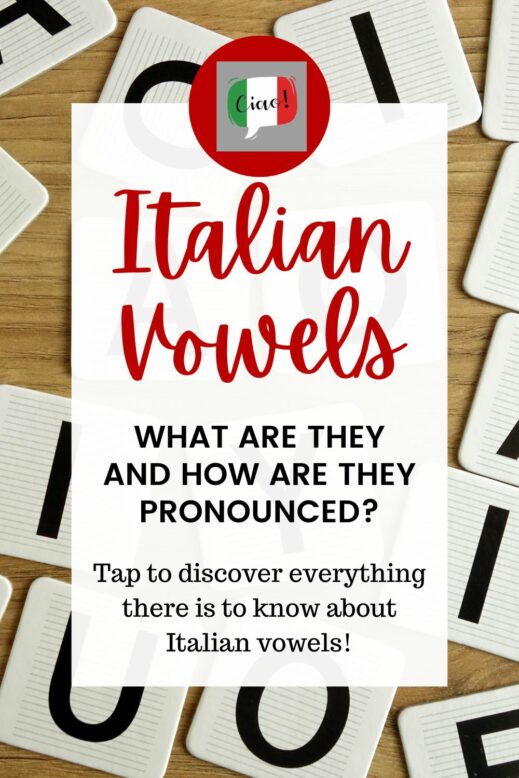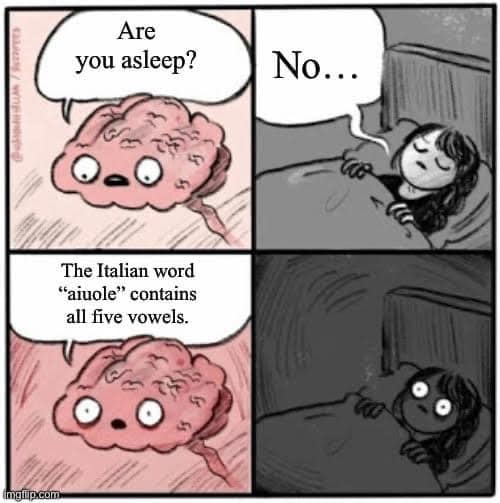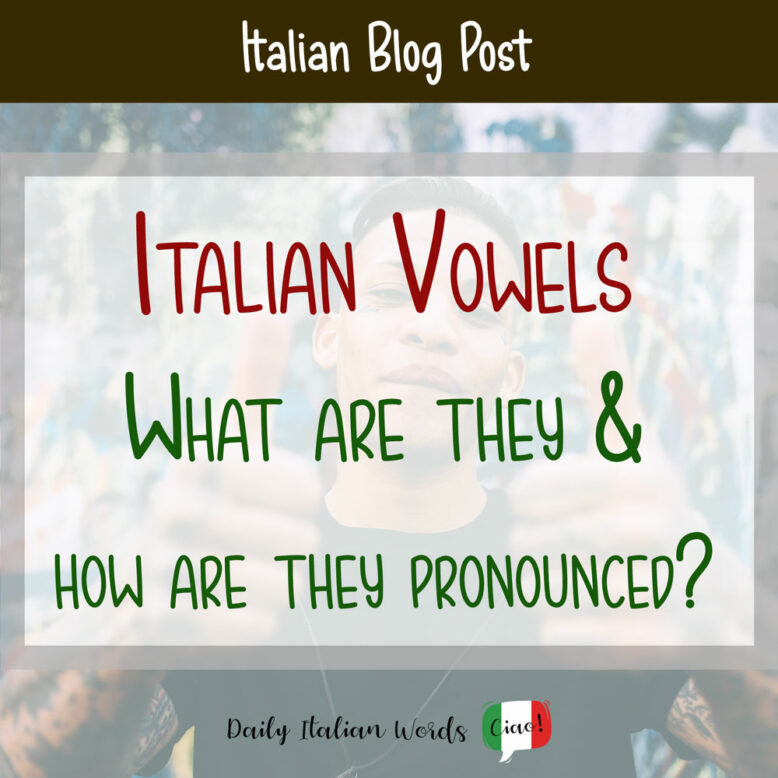There are two basic types of sounds in Italian, and any language for that matter – vowels and consonants.
Consonants are created when you use different parts of your mouth, such as your lips, tongue or palate, to obstruct the airflow. Vowels, on the other hand, are produced when you allow air to flow unobstructed. What differentiates one Italian vowel from another is how the tongue is positioned in the mouth.
If you are curious to learn all the Italian vowels and how they are pronounced, look no further – we’ve got you covered!

What are the Italian vowels?
The Italian alphabet consists of five vowels: a, e, i, o and u. These vowels can be divided into two categories: “one-sound vowels” and “two-sound vowels”.
The letters a, i and u are always pronounced in the same way, which is why they are called “one-sound vowels”, whereas e and o each have a so-called “closed sound” and “open sound”, making them “two-sound vowels”. The recordings below contain each of these seven vowel sounds, along with three example words, so you can hear it used in context:

A – /a/
Example words: ala (wing), banana (banana), basta (enough)
Open “E” – /ɛ/
Example words: certo (certain), bello (beautiful), bene (good)
Closed “O” – /o/
Example words: dono (gift), mondo (world), nome (name)

In a stressed position, both open and closed variants of “e” and “u” may occur, but in an unstressed position, you will only ever encounter the closed variant.
Sometimes the meaning of a word can change depending on the pronunciation of “e” and “o“. A commonly referenced example is the word pesca, which when pronounced with an open “e” means “peach” whereas with a closed “e” it means “fishing“.
Another good example is venti (as in the number twenty) and venti (as in the plural of vento meaning “wind”). The former is pronounced with a closed “e” while the latter requires an open “e“.
Acute and grave accents in Italian can also help you figure out whether the vowel is open or closed. A grave accent (è / ò) always tells you the vowel is open whereas the acute accent (é) tells you it is closed.
Note: The ó with an acute accent does not exist in Italian.
Example words with an grave accent
può = (it) can
caffè = coffee
tè = tea
ciò = that
Example words with an acute accent
perché = because / why
né = neither / nor
benché = although
ventitré = twenty-three
Important: Depending on where you live in Italy, you may find that the local accent does not always respect the rules of standard Italian pronunciation. For example, in the south of Italy, people tend to use the open “e/o” in situations where someone speaking standard Italian would use the closed “e/o”. Coming back to the previous example pesca, Italians from Turin always pronounce this word with a closed “e” in reference to both peaches and fishing.

Unlike English, Italian vowels are pure, meaning that each letter always corresponds to one single vowel sound, never two combined vowel sounds (known as a diphthong).
Take for example a simple word like “no”. Despite being spelled the same in English and Italian with the single vowel ‘o’, it is pronounced /nəʊ/ (diphthong) in English and /nɔ/ (one pure vowel) in Italian.
That’s not to say that diphthongs (and indeed triphthongs) don’t exist in Italian – there are plenty – but each individual sound is almost always represented by a single letter, such as for example, the i and o in the word mio (mine) or the i and a in spia (spy).
Occasionally i may be pronounced like a ‘y’ (e.g. pietra is pronounced /ˈpjɛ.tra/ instead of /ˈpiɛ.tra/) and u may be pronounced like a ‘w’ (e.g. scuola is pronounced /ˈskwɔ.la/ instead of /ˈskuɔ.la/) but most of the time, each vowel retains its normal value. Source: Italian Pronunciation A Primer for Singers
Below is a full list of diphthongs that occur in Italian:
ae > saetta (arrow)
ai > zaino (backpack)
ao > maori (Maori)
au > cauto (cautious)
ea > beato (blessed)
ei > dei (gods)
eo > leone (lion)
eu > euro (euro)
ua > tua (yours)
ue > bue (ox)
ui > Luisa
uo > buono (good)
oa > koala (koala)
oi > oibò (oh my)
oe > Cloe
ia > mia (mine)
ie > mie (mine)
io > mio (mine)
iu > più (more)
A few triphthongs:
uoi > suoi (theirs)
iei > miei (mine)
uio > buio (dark)
Did you know that…?
The word aiuola (flowerbed) contains four vowel sounds (a, i, u and o) side by side. The plural form aiuole is a famous example of a single word that contains all five vowels!


Heather Broster is a graduate with honours in linguistics from the University of Western Ontario. She is an aspiring polyglot, proficient in English and Italian, as well as Japanese, Welsh, and French to varying degrees of fluency. Originally from Toronto, Heather has resided in various countries, notably Italy for a period of six years. Her primary focus lies in the fields of language acquisition, education, and bilingual instruction.


